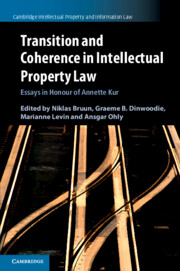Book contents
- Transition and Coherence in Intellectual Property Law
- Cambridge Intellectual Property and Information Law
- Transition and Coherence in Intellectual Property Law
- Copyright page
- Contents
- Preface
- Greetings to Annette Kur from the Second Floor
- Annette Kur: Toward Understanding
- Part I Transition
- Part II Coherence
- A Intellectual “Property” and its Limits
- B IP Overlaps
- 25 Intellectual Property in Transition: The Several Sides of Overlapping Copyright and Trademark Protection
- 26 Cultural Heritage and the Public Domain: What the US’s Myriad and Mayo can Teach Oslo’s Angry Boy
- 27 Public Order in the Light of Aesthetic Theory: The Copyright/Trademark Interface after Vigeland
- 28 Separability as Channeling: A Cautionary Tale
- 29 Novelty, Idea or New Meaning as Criteria for Copyright Protection? Transitions in Swedish Design Law
- 30 Examining Functionality
- 31 Substantial Value and the Concept of Shapes
- 32 Copyright and Patents on Software: The UPC’s Answer to an Old Problem of Intellectual Property Overlaps
- 33 Chopping off Hydra’s Heads: Spare Parts in EU Design and Trade Mark Law
- C (Un-)fairness
- Conclusion
- Cambridge Intellectual Property and Information Law
25 - Intellectual Property in Transition: The Several Sides of Overlapping Copyright and Trademark Protection
from B - IP Overlaps
Published online by Cambridge University Press: 29 December 2020
- Transition and Coherence in Intellectual Property Law
- Cambridge Intellectual Property and Information Law
- Transition and Coherence in Intellectual Property Law
- Copyright page
- Contents
- Preface
- Greetings to Annette Kur from the Second Floor
- Annette Kur: Toward Understanding
- Part I Transition
- Part II Coherence
- A Intellectual “Property” and its Limits
- B IP Overlaps
- 25 Intellectual Property in Transition: The Several Sides of Overlapping Copyright and Trademark Protection
- 26 Cultural Heritage and the Public Domain: What the US’s Myriad and Mayo can Teach Oslo’s Angry Boy
- 27 Public Order in the Light of Aesthetic Theory: The Copyright/Trademark Interface after Vigeland
- 28 Separability as Channeling: A Cautionary Tale
- 29 Novelty, Idea or New Meaning as Criteria for Copyright Protection? Transitions in Swedish Design Law
- 30 Examining Functionality
- 31 Substantial Value and the Concept of Shapes
- 32 Copyright and Patents on Software: The UPC’s Answer to an Old Problem of Intellectual Property Overlaps
- 33 Chopping off Hydra’s Heads: Spare Parts in EU Design and Trade Mark Law
- C (Un-)fairness
- Conclusion
- Cambridge Intellectual Property and Information Law
Summary
In this chapter, we address the phenomenon of overlapping trademark and copyright protection under United States (U.S.) law, which represents, in our view, an important example of intellectual property (IP) rights in transition. The Lalique bottles created for Nina Ricci perfumes, for example, may enjoy both copyright and trademark protection.3 Similarly, cartoon characters are components of copyrightable works (and in some jurisdictions, may be copyrightable works in their own right),4 but many have also long been registered as trademarks for entertainment services or merchandise.5 Copyright and trademark protections will overlap when the same object is both an original work of authorship but also serves to identify and distinguish one producer’s goods or services. In theory, the regimes promote different objectives: creativity in the case of copyright, and source identification (or more abstractly, honest market information) in the case of trademarks. The contours of protection differ as well. U.S. copyright law covers original works of authorship; these include a large array of creations, including pictures, architectural works, computer software, and even some works of applied art, so long as they are minimally creative. By contrast, under U.S. law, a trademark need not be creative (though many in fact might be), but it must be “distinctive,” because a sign that does not identify and distinguish goods or services does not fulfil its function of identifying products in the market place as originating with a single source.6 Accordingly, even though creativity is different from distinctiveness, some trademarks can be original works of authorship and some creative works can be distinctive signs.
- Type
- Chapter
- Information
- Transition and Coherence in Intellectual Property LawEssays in Honour of Annette Kur, pp. 307 - 321Publisher: Cambridge University PressPrint publication year: 2021



